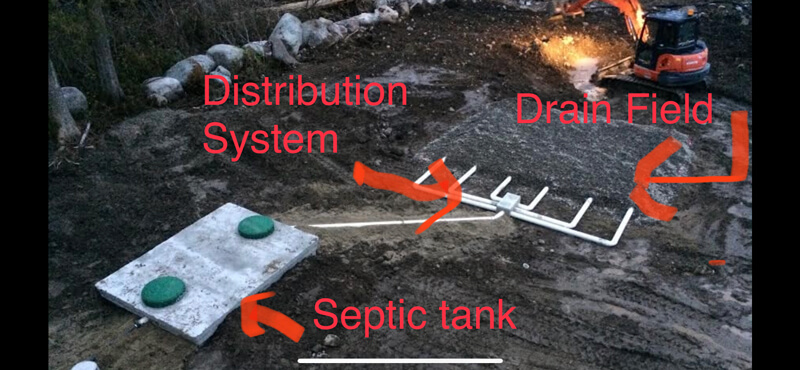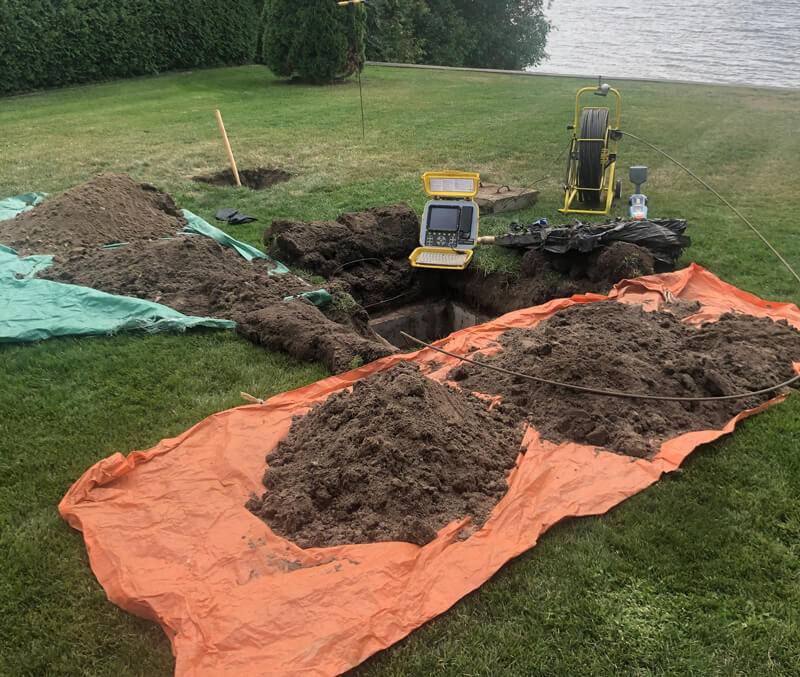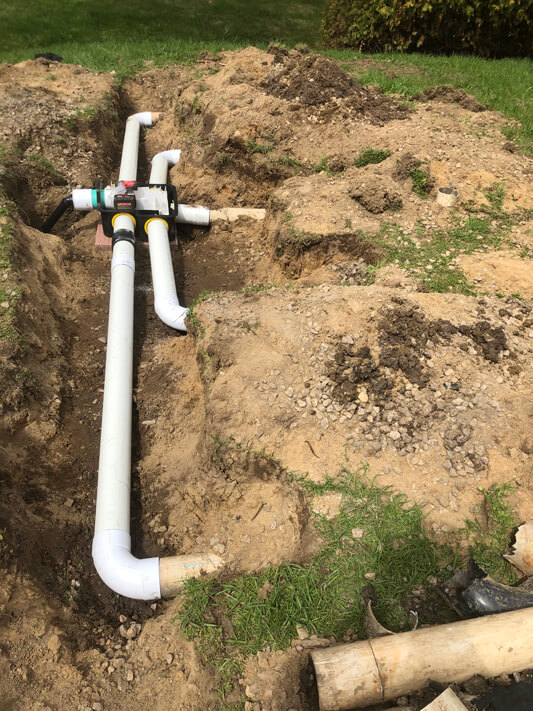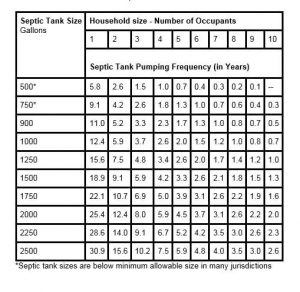What is a septic system?
A septic system is essentially a bacteria supported system designed to treat human waste before it is released back into the soil and environment. A typical system has 2 components: a septic tank and a drainage field or sometimes referred to as a septic bed, leaching bed, absorption field, tile bed, etc. How it works: Everything you put down the drain in the house enters the septic tank. The tank is divided into two compartments: one for solid waste and the other for liquid waste often referred to as effluent. The solid waste remains in the septic tank until it is pumped out and the effluent remains in the tank for a settling period then it flows out to the distribution system which then evenly distributes the effluent to the drainage field for further treatment. The drainage field is essentially a large sandbox comprised of pipes (tiles) and stone used to further treat the effluent before being released into the surrounding soil and water table. This is why it is important to have a properly functioning system to avoid contaminating nearby water courses and more importantly your drinking water!

License: BCIN # 37156/37028
When to call Underground Solutions
People get us involved when:
a) they start having difficulty flushing their toilets or draining their showers
b) they start smelling odors outside or seeing black effluent pooling on the grass surface
c) they cannot find their septic tank in order to pump it out
d) they want to change their effluent or sewage pump
e) they want to make changes to their system to increase longevity
f) they simply want to know where their septic system is located and how well is it performing
g) they are purchasing a home on septic and want to know more about the system
SERVICES OFFERED

Septic system inspections:
Because every septic system is different, we treat them as such. We utilize years of knowledge and specialty equipment to gain access to your system’s various components in order to give you a proper analysis of what’s in place and how it is performing. We use minimally invasive techniques such as cameras to avoid unnecessary damages to the system and the landscaping.
Septic system repair:
there are many components that make up a septic system and they all play a key role in the treatment process but sometimes these components break down and need attention before matters get worse. We have the ability to identify these components and repair or replace them to increase the longevity of your system.

Septic system design:
like all projects, the key to success is planning. This holds especially true with septic systems. If you are not diligent with the design process you may end up with a system that isn’t functioning properly, is a real eye sore to the surrounding landscape and/or a hazard to nearby water courses such as streams, rivers and lakes and even worse your drinking water! We take our designs very seriously and we work closely with our clients to provide them with both a system that functions properly and one that blends in right on their property.
Septic system installation:
there are numerous types of systems and system components available depending on factors such as: accessibility, lot size, soil characteristics, sensitive sites and budget. Examples of these systems include: Filter bed systems, Trench bed systems and various Tertiary systems that are more advanced than the previous two systems but can offer solutions the others can’t. No two homes are the same and we treat them all on a case by case basis. So whether you’re building a new home or require a replacement system, we can help. If your terrain is undeveloped and seems difficult or impossible to travel through, we can help. If you have a cottage on an island that requires a septic system, we can help. We have done some real challenging systems over the years and I have yet to find one we couldn’t do so if it’s a challenge you have, it’s a challenge I am willing to take!
How to care for your septic system (septic do’s and don’ts)
Be careful what you put down the drain:
Limit the amount of fat and oil that is flush down the system. Carefully wiping the grease off your pans before washing them will minimize the amount of fats that accumulate in the system. While the septic tank is designed to hold back the fats and oils from entering the drainage field too much of it can force some to exit the tank and cause blockage in the drainage field. Also avoid food garburators. They increase the amount of solids in a septic tank which reduces the volume in the tank designed to break down matter which will leave you with poorly treated effluent and the need for added pumping cycles.
The number one killer of septic systems:
The number one killer of septic systems in my opinion is water! Adding too much water to a system that isn’t designed for that much volume will either hydraulically overload the system preventing it from seeping into the ground and/or force water out of the septic tank faster than it can be treated which can jeopardize the longevity of the drainage field or pose a threat to the environment.
Avoid harsh chemicals:
Avoid harsh chemicals such as paints, cleaners, solvents and most common bleach. Your septic system is an environmental ecosystem. The system relies heavily on billions of microorganisms to break down our sewage before it re-enters into the environment. Careless use of chemicals could kill these hard working organisms which would leave the sewage untreated causing premature failure of the system and create serious environmental hazard. Always consider “septic safe products” when shopping for cleaners, soap and laundry detergents.
Clean your septic tank filter:
Filters became mandatory in 2007, failure to clean them 1-2 times a year can cause slow to zero drainage to the drainage field.

Pump your septic tank when required is the best practice:
 You don’t want to wait too long where solids can start infiltrating the drainage field and you don’t want to pump it too often which will cost you more money and you are removing the hard working bacteria designed to decompose household sewage. A safe guideline is every 3-5 years depending on usage or follow the pumping chart which gives you a better idea based on the size of your tank and the number of people living in the house. The most accurate method is to pump it out when the volume of the solid side of the tank is ⅓ solid.
You don’t want to wait too long where solids can start infiltrating the drainage field and you don’t want to pump it too often which will cost you more money and you are removing the hard working bacteria designed to decompose household sewage. A safe guideline is every 3-5 years depending on usage or follow the pumping chart which gives you a better idea based on the size of your tank and the number of people living in the house. The most accurate method is to pump it out when the volume of the solid side of the tank is ⅓ solid.
